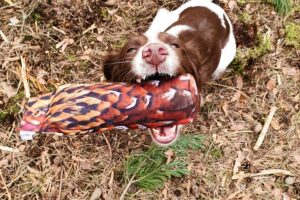If you’ve ever looked at your once-lovely, obedient puppy and thought, who on earth swapped my dog for this hooligan?, welcome to adolescent gundog behaviour.
This is the stage that makes even experienced handlers question everything. One minute they’re walking nicely, the next they’re off chasing a bird, ignoring your recall like they’ve never heard the word before. It’s not just you, every gundog owner goes through it.
Adolescence is a phase of big feelings and bigger impulses. Your dog’s hormones are up, their focus is down, and their confidence is all over the shop. It’s like living with a teenager who’s just discovered energy drinks.
But here’s the thing: this isn’t bad behaviour, it’s normal development. And how you handle this stage determines what sort of adult dog you’ll end up with. So rather than losing your cool (or your lead), let’s look at three proven ways to manage this phase with kindness, structure, and a bit of humour.
If you’d like a step-by-step foundation to rebuild focus during this stage, the the Hot Mess Handler course walks you through everything you need to know to reconnect with your dog calmly and confidently
Strategy One: Managing Adolescent Gundog Behaviour in Real Life
You can’t reason with teenage hormones… trust me, I’ve tried. But you can manage the situations that bring out your dog’s worst decisions.
Adolescence is when you stop assuming they’ll make good choices and start setting them up so they can’t make disastrous ones. Think of yourself as their “behavioural safety net.”
Here’s how:
Spot patterns. Notice when and where chaos happens. Is it always at the park gate? When other dogs appear? Around certain smells or sounds?
Pre-empt the chaos. Clip on the long line before they lose their recall. Change direction before they get overstimulated. Step in early, not after the damage is done.
Interrupt, don’t punish. A friendly “this way!” or recall cue will do more good than shouting once they’ve disappeared into the hedgerow.
The aim here isn’t control, it’s prevention. The less your dog rehearses unwanted behaviour, the faster they grow out of it. You’re protecting their learning, not stifling their freedom.
And yes, it means you might be on the long line for a few months, but think of it as a seatbelt… inconvenient, sure, but it keeps everyone safe while the brain catches up with the body.

Strategy Two: Channel the Chaos for Better Gundog Behaviour
A bored adolescent gundog is basically a four-legged demolition expert. They’ve got drive, energy, and instincts and if you don’t give those instincts a job, they’ll find one. Usually it involves runnning off, being a bum hole, or stealing your socks.
The trick with adolescent gundog behaviour is not to take it personally. When your dog ignores you, it’s not rebellion, it’s biology. Their working instincts are firing on all cylinders, and they’re learning how to handle them.
Instead of trying to suppress that energy, redirect it. Give their natural drives something productive to do.
Here’s what that looks like:
Controlled retrieves. Keep them short and purposeful. Ask for focus before each one, so it’s not just a game of fetch, it’s a thinking exercise.
Search and find games. Hide treats or dummies in easy spots and encourage them to hunt with their nose. It satisfies their working brain and burns mental energy.
“Parkour” walks. Ask for sits on logs, waits at gates, or heelwork around obstacles. Keeps them engaged and thinking, without overdoing the physical side.
These activities teach your dog that working with you is rewarding, not restrictive.
Because the truth is, a gundog’s instinct isn’t the enemy, it’s their superpower. When you give it a job to do, that’s when you start to see maturity grow through the madness.

Strategy Three: Pick Your Battles (and Win the Important Ones)
When you’re living with an adolescent dog, it can feel like every day’s a test. You’ll catch yourself saying “no” more than you breathe. But not every battle needs fighting.
If you try to tackle everything at once, you’ll both burn out. Instead, focus on the foundations (the few things that keep life calm and safe) and let the rest go for now.
Here’s what that means:
Prioritise recall, lead walking, and calm settling. These three will carry you through most situations. Everything else can wait.
Stick to predictable routines. Adolescents thrive on structure. Keep meal times, walks, and training sessions roughly the same each day.
Reset rather than react. When they mess up (and they will), take a breath, guide them back to calm, and move on. Frustration teaches nothing; steadiness teaches everything.
This isn’t about being soft. It’s about being strategic. You’re saving your energy for the lessons that actually matter, so you both come out of this phase stronger.
Because honestly, the goal isn’t perfection, it’s keeping your relationship intact while their brain’s temporarily out to lunch
Why These Three Work
Together, these three strategies do more than just get you through adolescence — they build the kind of foundation every future working or companion gundog needs:
Managing moments of madness protects your progress.
Channelling chaos into purpose meets their instinctive needs.
Picking your battles strengthens your bond and builds trust.
They’re not quick fixes, but they’re the difference between surviving adolescence and thriving through it.
If you’d love to learn how to bring more calm into your dog’s daily life, our Calm Dog Blueprint offers practical, gentle guidance that fits real life.
The Bit Nobody Tells You
There’ll be days when it all feels like too much. When the recall fails, the lead’s covered in mud, and you’re questioning why you ever thought this was a good idea. Those are the moments that make handlers, not the perfect training sessions, but the messy, real, human ones.
Adolescence is temporary. Your patience, your consistency, and your calm are what carry your dog through it.
And one day, maybe when you’re standing in a field with your dog sitting steady beside you, you’ll realise that all those small, steady choices added up to something solid.
So pour yourself a cuppa, take a deep breath, and remember: you’re not alone in this. Every handler with mud on her boots and a lead in her pocket has been right where you are.
And the fact you’re still showing up? That’s what makes you a great one.

Quick Recap:
- Manage the moments of madness. Prevention over punishment.
- Channel the chaos into purpose. Give energy direction.
- Pick your battles. Focus on what really matters right now.
You May Also Enjoy:


Why Your Gundog Training Feels Different in Winter (And Why That’s Okay)


Why Gundogs Love Carrying Things in Their Mouths (4 Reasons Explained)


Surviving the Teenage Phase: Managing Adolescent Gundog Behaviour
- adolescent dog behaviour
- adolescent gundog
- behaviour management
- calm dog training
- gundog adolescence
- gundog behaviour
- gundog focus
- Gundog Training
- Ladies Working Dog Group
- lead walking
- recall training
- rural dog training
- teenage dog phase
- teenage gundog
- Working Dog Training
Join Our Online Community!
Jump on our email list for free tips and insights delivered to your inbox monthly. No spam - just quick bites of value.

